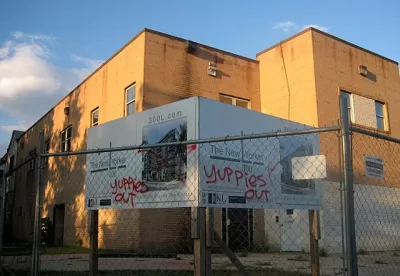The general principle is simple: more density equals lower prices and less environmental impact. But suburbia's imprint is deep, both on cities themselves and on how we expect to inhabit them.

In an article on Grist, Ben Adler doubts whether the urbanist trend will be enough to combat the ills of low density. Although urban populations are rising, "We're watching the demographics of cities change without getting the carbon-emissions-reducing benefits that the back-to-the-cities movement promised."
After decades of what we now consider underdevelopment, cities face chronic housing shortages. "Given that it's the capital of a country with twice as many people as in 1950, you wouldn't expect Washington to have shrunk, would you? Well, it has, and it hasn't fully bounced back."
And even though developers are steadily adding units, social factors stemming from the suburban boom are getting in the way. "D.C. doesn't suffer from a shrinking stock of housing. In fact, it has the most dwelling units in its history — it just has fewer people in each home [...] Middle-class Americans have simply become accustomed to more private space and comfort than previous generations."
Adler traces part of the problem to the racial and spacial vagaries of urban infilling. "In certain neighborhoods that have become trendy, high demand bids up housing prices, empty lots get filled in, and the population grows. In other neighborhoods, demand remains low and abandonment continues." Environmentalists (and some urbanists) want to fill in these empty spaces, only to confront inevitable gentrification and displacement as prices rise.
FULL STORY: Thanks to social change, urban density ain’t what it used to be

Pennsylvania Mall Conversion Bill Passes House
If passed, the bill would promote the adaptive reuse of defunct commercial buildings.

Planning for Accessibility: Proximity is More Important than Mobility
Accessibility-based planning minimizes the distance that people must travel to reach desired services and activities. Measured this way, increased density can provide more total benefits than increased speeds.

World's Largest Wildlife Overpass In the Works in Los Angeles County
Caltrans will soon close half of the 101 Freeway in order to continue construction of the Wallis Annenberg Wildlife Crossing near Agoura Hills in Los Angeles County.

Alaska Village Becomes Test Case for Climate Change Relocation
The Yup’ik village of Newtok is the first Alaska community to begin a full-scale relocation necessitated by the impacts of climate change. Another 31 Alaska communities remain vulnerable.

Amtrak Takes Lead on Texas Central Rail
The high-speed rail project isn’t a done deal, but if it moves forward, trains could begin operating in 2030.

Maine Approves Rent Relief Program
Legislators hope the assistance program will help struggling low-income households avoid eviction.
City of Costa Mesa
Licking County
Barrett Planning Group LLC
HUD's Office of Policy Development and Research
Mpact Transit + Community
HUD's Office of Policy Development and Research
Tufts University, Department of Urban and Environmental Policy & Planning
City of Universal City TX
ULI Northwest Arkansas
Urban Design for Planners 1: Software Tools
This six-course series explores essential urban design concepts using open source software and equips planners with the tools they need to participate fully in the urban design process.
Planning for Universal Design
Learn the tools for implementing Universal Design in planning regulations.


























